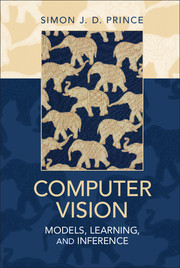Refine search
Actions for selected content:
526 results in Image processing and machine vision
5 - Dense Correspondence and Its Applications
-
- Book:
- Computer Vision for Visual Effects
- Published online:
- 05 December 2012
- Print publication:
- 19 November 2012, pp 148-206
-
- Chapter
- Export citation
B - Figure Acknowledgments
-
- Book:
- Computer Vision for Visual Effects
- Published online:
- 05 December 2012
- Print publication:
- 19 November 2012, pp 364-366
-
- Chapter
- Export citation
Contents
-
- Book:
- Computer Vision for Visual Effects
- Published online:
- 05 December 2012
- Print publication:
- 19 November 2012, pp vii-x
-
- Chapter
- Export citation
3 - Image Compositing and Editing
-
- Book:
- Computer Vision for Visual Effects
- Published online:
- 05 December 2012
- Print publication:
- 19 November 2012, pp 55-106
-
- Chapter
- Export citation
7 - Motion Capture
-
- Book:
- Computer Vision for Visual Effects
- Published online:
- 05 December 2012
- Print publication:
- 19 November 2012, pp 255-299
-
- Chapter
- Export citation
4 - Features and Matching
-
- Book:
- Computer Vision for Visual Effects
- Published online:
- 05 December 2012
- Print publication:
- 19 November 2012, pp 107-147
-
- Chapter
- Export citation
Frontmatter
-
- Book:
- Computer Vision for Visual Effects
- Published online:
- 05 December 2012
- Print publication:
- 19 November 2012, pp i-vi
-
- Chapter
- Export citation
A - Optimization Algorithms for Computer Vision
-
- Book:
- Computer Vision for Visual Effects
- Published online:
- 05 December 2012
- Print publication:
- 19 November 2012, pp 353-363
-
- Chapter
- Export citation
Index
-
- Book:
- Computer Vision for Visual Effects
- Published online:
- 05 December 2012
- Print publication:
- 19 November 2012, pp 393-398
-
- Chapter
- Export citation
6 - Matchmoving
-
- Book:
- Computer Vision for Visual Effects
- Published online:
- 05 December 2012
- Print publication:
- 19 November 2012, pp 207-254
-
- Chapter
- Export citation
Bibliography
-
- Book:
- Computer Vision for Visual Effects
- Published online:
- 05 December 2012
- Print publication:
- 19 November 2012, pp 367-392
-
- Chapter
- Export citation

Computer Vision
- Models, Learning, and Inference
-
- Published online:
- 05 August 2012
- Print publication:
- 18 June 2012
-
- Textbook
- Export citation
1 - Introduction
-
- Book:
- Computer Vision
- Published online:
- 05 August 2012
- Print publication:
- 18 June 2012, pp 1-6
-
- Chapter
- Export citation
7 - Modeling complex data densities
- from II - Machine learning for machine vision
-
- Book:
- Computer Vision
- Published online:
- 05 August 2012
- Print publication:
- 18 June 2012, pp 71-107
-
- Chapter
- Export citation
13 - Image preprocessing and feature extraction
- from IV - Preprocessing
-
- Book:
- Computer Vision
- Published online:
- 05 August 2012
- Print publication:
- 18 June 2012, pp 269-294
-
- Chapter
- Export citation
12 - Models for grids
- from III - Connecting local models
-
- Book:
- Computer Vision
- Published online:
- 05 August 2012
- Print publication:
- 18 June 2012, pp 227-266
-
- Chapter
- Export citation
16 - Multiple cameras
- from V - Models for geometry
-
- Book:
- Computer Vision
- Published online:
- 05 August 2012
- Print publication:
- 18 June 2012, pp 354-384
-
- Chapter
- Export citation
2 - Introduction to probability
- from I - Probability
-
- Book:
- Computer Vision
- Published online:
- 05 August 2012
- Print publication:
- 18 June 2012, pp 9-16
-
- Chapter
- Export citation
11 - Models for chains and trees
- from III - Connecting local models
-
- Book:
- Computer Vision
- Published online:
- 05 August 2012
- Print publication:
- 18 June 2012, pp 195-226
-
- Chapter
- Export citation
15 - Models for transformations
- from V - Models for geometry
-
- Book:
- Computer Vision
- Published online:
- 05 August 2012
- Print publication:
- 18 June 2012, pp 323-353
-
- Chapter
- Export citation
